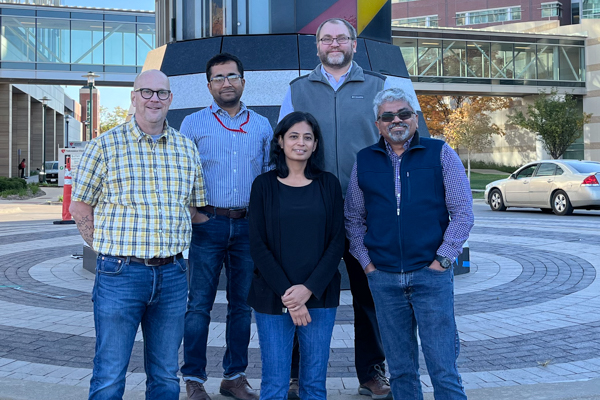Nebraska Pediatric Drug Discovery Group

The major goal of the Nebraska Pediatric Drug Discovery Group (NPDDG) is to develop small molecules that bind to, inactivate, or degrade fusion oncoproteins that drive pediatric cancer by functioning as regulators of transcription.
We have assembled a team that will focus on the discovery and development of small molecule modulators that perturb fusion oncoproteins that drive pediatric cancers. The team brings expertise in viz., CHemoINformatics (CHIN), Medicinal Chemistry & Chemical Biology (MCCB), Hit-to-Lead Characterization Core (H2LCC) and Cancer Cell & Molecular Biology (CCMB) to NPDDG. The multidisciplinary team, will enable the development of a therapeutic pipeline to accelerate drug discovery focused on developing NCEs that target fusion oncoproteins.
The assembled investigators are experts in protein folding, virtual screening, neural network methods to integrate heterogenous data (CHIN), hit-to-lead optimization, structure-activity-relationship studies, lead optimization, photocrosslinkable and clickable probes (MCCB), structural biology, biophysics, pharmacokinetics, toxicity, chemical proteomics (H2LCC), mechanism-based assay design and development, animal models of fusion oncoprotein driven pediatric cancer models, and pediatric oncology (CCMB). This group of investigators have published together and are PIs on a total of 16 R01/R00 grants (CA197999, CA226436, CA244900, CA250383, CA260749, CA263504, CA276846, GM136859, GM138920, GM141232, GM145647, HD106590, NS106879, NS116037, NS119266, and NS127439), thus demonstrating the cohesive nature and the high scientific caliber. Please note: Drs. Hopkins, Natarajan, & Trippier (MCCB) are listed as inventors on a combined 41 patents, thus demonstrating their ability to develop intellectual property (IP).
ChemoINformatics (CHIN)
Babu Guda, PhD
CHIN Principal Investigator
Professor, Vice Chair for Bioinformatics Research & Training, UNMC Department of Genetics, Cell Biology, and Anatomy

Hari Arthanari, PhD
Associate Professor, Biological Chemistry and Molecular Pharmacology, Harvard Medical School
Kabhilan Mohan, PhD
Instructor, UNMC Eppley Institute for Research in Cancer and Allied Diseases
Medicinal Chemistry and Chemical Biology (MCCB)
Amar Natarajan, PhD
MCCB Principal Investigator
Ruth Branham Professor, UNMC Eppley Institute for Research in Cancer and Allied Diseases



Hit-to-Lead Characterization Core (H2LCC)
Gloria Borgstahl, PhD
H2LCC Principal Investigator
Professor, UNMC Eppley Institute for Research in Cancer and Allied Diseases

Nick Wood, PhD
Assistant Professor, UNMC Eppley Institute for Research in Cancer and Allied Diseases

Cancer Cell and Molecular Biology (CCMB)
Gargi Ghosal, PhD
CCMB Principal Investigator
Gargi Ghosal, PhD Associate Professor, Department of Genetics, Cell Biology, and Anatomy



Kate Hyde, PhD
Kate Hyde, PhD Associate Professor, UNMC Department of Biochemistry and Molecular Biology

Research Project Information
The specific goals of the NPDDG are the following:
- Design, synthesize and evaluate small molecule modulators of EWS::FLI1 for Ewing sarcoma therapy
- Design, synthesize and evaluate small molecule modulators of Cbfb::MYH11 for pediatric AML therapy
- Design, synthesize and evaluate small molecule modulators of SS18::SSX for sinovial sarcoma therapy
The entire team is currently focused on developing small molecule modulators that target EWS::FLI1. CHIN will use the in silico methods to develop an EWS::FLI1 protein-protein interaction complex and explore virtual high throughput screen (vHTS) with billion compound libraries to identify hits. The tight binders will be subjected to pan-assay interference (PAINS) filter, and those that pass the PAINS filter will be subjected to Schrödinger QikProp predictive in silico DMPK and ACD percepta ADME/Tox module to eliminate compounds that are likely to have adverse effects in animals. MCCB will analyze the data using visualization software such as data explorer and prioritize compounds that should be considered for synthesis. Structure activity relationship (SAR) by catalog and hit-to-lead optimization will be supported by H2LCC and CCMB.